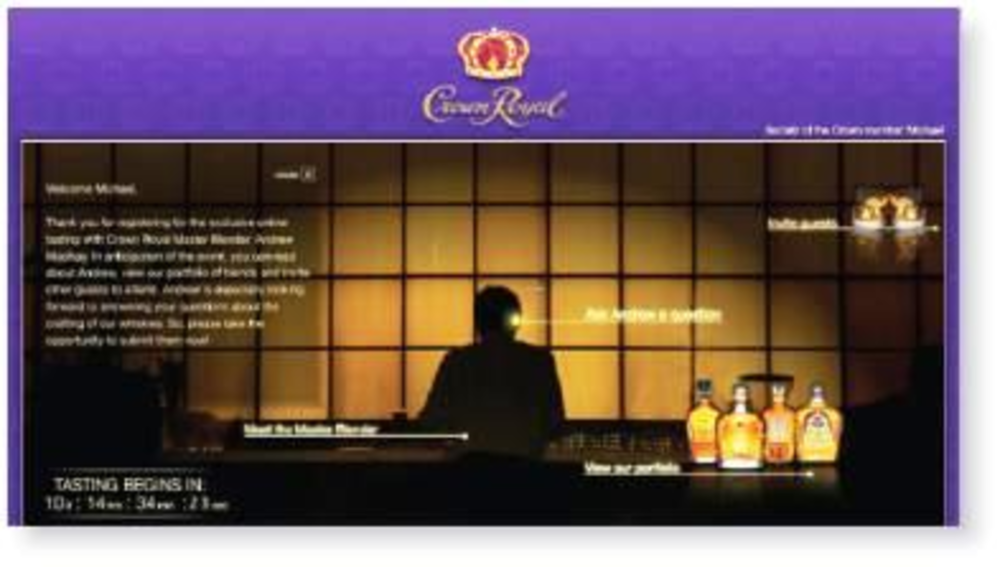With online marketing for alcoholic beverages growing, spirits marketers are looking to reach 20- and 30-somethings who are spending more and more time on the Web. This means developing creative interactive campaigns that reach beyond a liquor brand’s corporate site.
“Wine and spirits competitors generally rely on brand awareness campaigns to generate sales and engage consumer loyalty,” says David Tapscott, brand director of whisky brand Crown Royal. “However, as media consumption shifts, many brands are realizing the importance of connecting with consumers outside of traditional media.”
The unique challenge for liquor marketers, however, is that they must avoid minors in a medium that, for the most part, lacks policing. “The Internet is a bit loose, and many marketers carry an age verification statement that needs to be completed in order to enter their respective sites,” explains Roseann Sessa, VP of marketing and public relations for independent spirits supplier Castle Brands.
Castle Brands includes a social responsibility message on every piece of marketing and promotional material, as does Brazilian rum importer Leblon USA. “The most important thing a marketer can do is ensure they are talking to adult audiences,” says Steve Luttman, CEO of Leblon, who adds that marketers should be “careful about anything that appeals to college students.”
But age restrictions cannot guarantee that minors are not viewing a site. “It’s impossible to ensure that no one under 21 views alcohol-related product placements,” explains John Glover, SVP of marketing at Castle Brands, who points out that billboards, subway advertising and radio are accessible media to those under 21.
Not all alcoholic beverage marketers are affected heavily by underage consumers. For example, younger people are typically uninterested in K&L Wine Merchants, which specializes in rare and little-known wines. However, the company doesn’t take chances. “We do have an age restriction element and an adult signature is required upon delivery,” says Brian Zucker, co-owner of K&L, which works with StrongMail on e-mail marketing campaigns that introduce boutique-style wines to an opt-in list.
An even larger issue in the spirits sector, say experts, is how to stand out in an overcrowded market. “The real key is to create consumer communication on the Internet, because nobody really wants to log on to a liquor site unless it’s for a good reason,” Glover explains.
Fortunately, says Luttman, there are many consumers to market to in wine and spirits. “There are a lot of different brands and categories out there, but the market is very large,” he says, adding that consumers look for more variety and less duplication. “A [new] category will have a greater chance of finding a place vs. another vodka, tequila or gin,” he explains.
As marketing continues to move toward the Internet, it will be critical for the spirits sector to find a way to create compelling sites that go beyond pure purchase while maintaining a social responsibility. “Creating fun and out-of-the-box marketing content does not indicate that we’re targeting those below the legal drinking age,” says Glover.
Luttman emphasizes that, especially online, traditional marketing tools do not work.
“You need to be truthful and authentic,” he explains. “If we use our old marketing CPG skill set online, it doesn’t work — especially with sophisticated spirits where consumer involvement with the brand is greater.”
Crown Royal
Virtual tasting
In December 2007, members of the Society of the Crown, Crown Royal’s consumer loyalty program, received invitations by direct mail and e-mail to a special microsite – TasteCrownRoyal.com – which offered a seven-part “virtual tasting” event, in which Master Blender Andrew MacKay described the characteristics of three Crown Royal premier blends. A “send to friend” function enabled consumers to spread the word. There were more than 20,000 unique visitors to the microsite, while more than 2,000 Society of the Crown members/friends participated in the online tasting.
Leblon
Integrated campaign
In the first quarter of 2008, Leblon launched a two-month campaign around the Braziliancelebration of Carnaval, which was aimed to boost sales of Leblon’s Cachaça and Caipirinha. An e-mail newsletter was followed by 200 on-site Carnaval Caipirinha parties, using its “Carnival in a Box” materials, including masks, necklaces,
bracelets, a CD, glow sticks and drink recipes. Leblon also offered podcasts of Carnaval music on its Web site. The $1.5 million campaign doubled Leblon’s volume and tripled its market share.
Boru Vodka
Online talent search
In late 2007, Castle Brands Inc. launched an online talent search for the most authentic bar band in the country. The final 15 bands had their music featured on Castle Brands’ Web site, with the winning band receiving music equipment valued at about $10,000, as well as a digital release from Roadrunner Records. Fans who voted were encouraged to “tell a friend” via a short drop-down menu survey and Boru Vodka added the top bands to its MySpace page. During the five-week voting period, Castle had nearly 9,000 voters register and a total of 62,000 votes.








